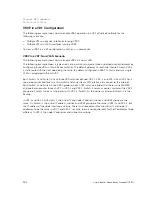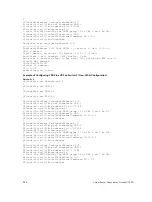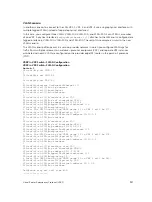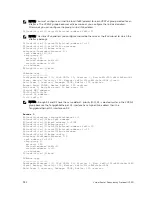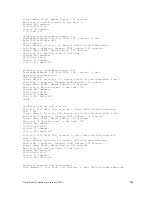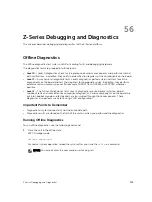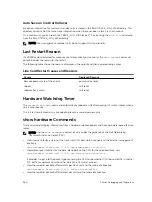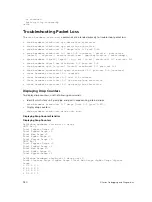
56
Z-Series Debugging and Diagnostics
This chapter describes debugging and diagnostics for the Z-Series platform.
Offline Diagnostics
The offline diagnostics test suite is useful for isolating faults and debugging hardware.
The diagnostics tests are grouped into three levels:
•
Level 0
— Level 0 diagnostics check for the presence of various components and perform essential
path verifications. In addition, they verify the identification registers of the components on the board.
•
Level 1
— A smaller set of diagnostic tests. Level 1 diagnostics perform status/self-test for all the
components on the board and test their registers for appropriate values. In addition, they perform
extensive tests on memory devices (for example, SDRAM, flash, NVRAM, or EEPROM) wherever
possible.
•
Level 2
— The full set of diagnostic tests. Level 2 diagnostics are used primarily for on-board
Loopback tests and more extensive component diagnostics. Various components on the board are
put into Loopback mode and test packets are transmitted through those components. These
diagnostics also perform snake tests using VLAN configurations.
Important Points to Remember
• Diagnostics only test connectivity, not the entire data path.
• Diagnostic results are stored on the flash of the unit on which you performed the diagnostics.
Running Offline Diagnostics
To run offline diagnostics, use the following command.
1.
Place the unit in the offline state.
EXEC Privilege mode
offline stack-unit
For normal system operation, reload the system after you issue the
offline
command.
NOTE: You cannot enter the command on a stacking unit.
Z-Series Debugging and Diagnostics
935
Summary of Contents for Z9000
Page 1: ...Dell Configuration Guide for the Z9000 System 9 7 0 0 ...
Page 80: ...grub reboot 80 Management ...
Page 128: ... 0 Te 1 1 Te 1 2 rx Flow N A N A 128 Access Control Lists ACLs ...
Page 491: ...Figure 70 Configuring OSPF and BGP for MSDP Multicast Source Discovery Protocol MSDP 491 ...
Page 496: ...Figure 73 MSDP Default Peer Scenario 1 496 Multicast Source Discovery Protocol MSDP ...
Page 497: ...Figure 74 MSDP Default Peer Scenario 2 Multicast Source Discovery Protocol MSDP 497 ...
Page 498: ...Figure 75 MSDP Default Peer Scenario 3 498 Multicast Source Discovery Protocol MSDP ...
Page 760: ...Figure 100 Single and Double Tag TPID Match 760 Service Provider Bridging ...
Page 761: ...Figure 101 Single and Double Tag First byte TPID Match Service Provider Bridging 761 ...




